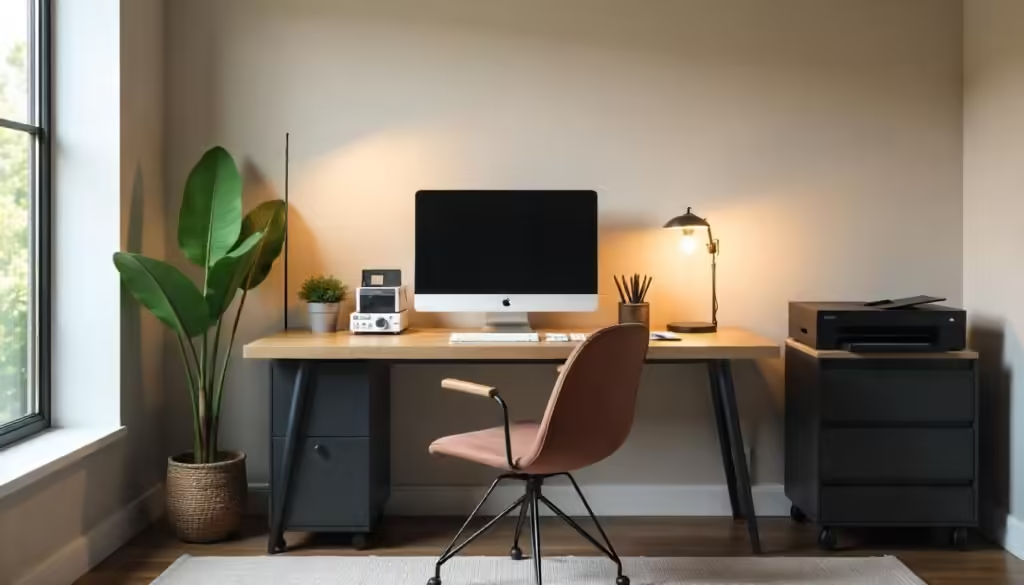Creating a productive home office setup can be a challenge, but it is definitely possible. With a little planning and effort, you can create a space that is both functional and inspiring.
Here are some tips for creating an effective home office setup:
- Choose a quiet location. Your home office should be in a quiet area of your home where you will not be disturbed. If possible, choose a room that is away from high-traffic areas.
- Invest in a good desk and chair. Your desk and chair should be comfortable and ergonomic. You will be spending a lot of time sitting at your desk, so it is important to invest in quality furniture.
- Organize your workspace. Keep your workspace organized and clutter-free. This will help you stay focused and productive.
- Add personal touches. Make your home office feel like your own by adding personal touches. This could include family photos, plants, or artwork.
- Take breaks. It is important to take breaks throughout the day. Get up and move around for a few minutes every hour. This will help you stay refreshed and focused.
- Set boundaries. Let your family and friends know that you are working when you are in your home office. This will help you avoid distractions.
- Use technology to your advantage. There are a number of apps and tools that can help you stay organized and productive.
- Make sure you have good lighting. Natural light is ideal, but if you don’t have a lot of windows, invest in a good desk lamp.
- Create a comfortable and inviting atmosphere. Add some plants, pictures, or other personal touches to make your home office feel like your own.
- Declutter your space. Keep your home office organized and free of clutter. This will help you stay focused and productive.
- Invest in a good chair. Your chair should be comfortable and adjustable so that you can find the perfect position.
- Use a standing desk. Standing desks can help you avoid back pain and improve your energy levels.
- Take advantage of natural light. If possible, set up your home office near a window so that you can enjoy natural light.
- Add some greenery. Plants can help to improve air quality and create a more relaxing atmosphere.
- Personalize your space. Add your own personal touches to your home office to make it feel like your own. This could include family photos, artwork, or anything else that makes you happy.
- Create a designated workspace. Even if you don’t have a separate room for your home office, it’s important to create a designated workspace where you can focus on your work.
- Keep your workspace organized. A cluttered workspace can be distracting and make it difficult to focus. Take some time each day to tidy up your workspace and put away any items that you’re not using.
- Invest in quality office supplies. Having good office supplies can make a big difference in your productivity. Invest in a good printer, scanner, and other essential office equipment.
- Take advantage of technology. There are a number of apps and tools that can help you stay organized and productive.
- Set realistic goals. Don’t try to do too much at once. Set realistic goals for yourself and break down large tasks into smaller, more manageable steps.
- Take breaks. It’s important to take breaks throughout the day to avoid burnout. Get up and move around for a few minutes every hour.
- Reward yourself. When you achieve a goal, reward yourself with something you enjoy. This will help you stay motivated.
- Find a work-life balance. It’s important to find a balance between your work and personal life. Make sure you’re not working too much and that you’re taking time for yourself and your family.
- Don’t be afraid to ask for help. If you’re struggling to create an effective home office setup, don’t be afraid to ask for help from friends, family, or a professional organizer.
Here are some additional tips for creating an effective home office setup:
- Consider your lighting. You’ll want to make sure you have good lighting in your home office so that you can see what you’re doing. Natural light is ideal, but if you don’t have a lot of windows, you’ll need to invest in good artificial lighting.
- Choose a comfortable chair. Your chair should be adjustable so that you can find the perfect position. You may also want to consider investing in a lumbar support pillow.
- Invest in a good desk. Your desk should be the right size for you and should have enough space for your computer, printer, and other office supplies.
- Organize your workspace. Keep your workspace organized and clutter-free. This will help you stay focused and productive.
- Add personal touches. Make your home office feel like your own by adding personal touches. This could include family photos, plants, or artwork.
- Take breaks. It’s important to take breaks throughout the day to avoid burnout. Get up and move around for a few minutes every hour.
- Set boundaries. Let your family and friends know that you are working when you are in your home office. This will help you avoid distractions.
- Use technology to your advantage. There are a number of apps and tools that can help you stay organized and productive.
- Make sure you have good ventilation. Good ventilation is important for your health and well-being. Make sure your home office has good ventilation, especially if you’re spending long hours there.
- Create a comfortable and inviting atmosphere. Add some plants, pictures, or other personal touches to make your home office feel like your own.
- Declutter your space. Keep your home office organized and free of clutter. This will help you stay focused and productive.
- Invest in a good chair. Your chair should be comfortable and adjustable so that you can find the perfect position.
- Use a standing desk. Standing desks can help you avoid back pain and improve your energy levels.
- Take advantage of natural light. If possible, set up your home office near a window so that you can enjoy natural light.
- Add some greenery. Plants can help to improve air quality and create a more relaxing atmosphere.
- Personalize your space. Add your own personal touches to your home office to make it feel like your own. This could include family photos, artwork, or anything else that makes you happy.
- Create a designated workspace. Even if you don’t have a separate room for your home office, it’s important to create a designated workspace where you can focus on your work.
- Keep your workspace organized. A cluttered workspace can be distracting and make it difficult to focus. Take some time each day to tidy up your workspace and put away any items that you’re not using.
- Invest in quality office supplies. Having good office supplies can make a big difference in your productivity. Invest in a good printer, scanner, and other essential office equipment.
- Take advantage of technology. There are a number of apps and tools that can help you stay organized and productive.
- Set realistic goals. Don’t try to do too much at once. Set realistic goals for yourself and break down large tasks into smaller, more manageable steps.
- Take breaks. It’s important to take breaks throughout the day to avoid burnout. Get up and move around for a few minutes every hour.
- Reward yourself. When you achieve a goal, reward yourself with something you enjoy. This will help you stay motivated.
- Find a work-life balance. It’s important to find a balance between your work and personal life. Make sure you’re not working too much and that you’re taking time for yourself and your family.
- Don’t be afraid to ask for help. If you’re struggling to create an effective home office setup, don’t be afraid to ask for help from friends, family, or a professional organizer.



